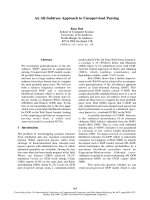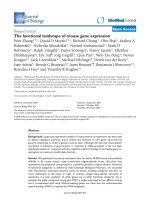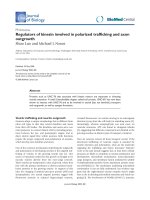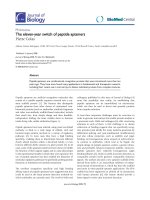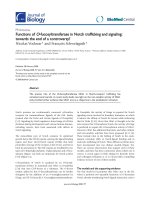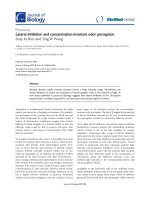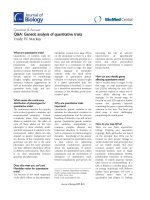Báo cáo sinh học: " Listing all sorting reversals in quadratic time" pdf
Bạn đang xem bản rút gọn của tài liệu. Xem và tải ngay bản đầy đủ của tài liệu tại đây (325.81 KB, 6 trang )
RESEARC H Open Access
Listing all sorting reversals in quadratic time
Krister M Swenson
1,2*
, Ghada Badr
3,4
and David Sankoff
1
Abstract
We describe an average-case O(n
2
) algorithm to list all reversals on a signed permutation π that, when applied to
π, produce a permutation that is closer to the identity. This algorithm is optimal in the sense that, the time it takes
to write the list is Ω(n
2
) in the worst case.
1 Introduction
In 1995 Hannenhalli and Pevzner [1] presented an algo-
rithm to transform one genome into another in a mini-
mum number of bio logically plausible moves. They
modeled a genome as a signed permutation and the
move that they considered was the reversal: the order of
a sub string of the permutation is reversed, and the sign
of each element in the substring is flipped. Since then
many refinements and speed improvements have been
developed [2-8].
In 2002 Siepel and Ajana et al. [9,10] showed how to
list every parsimonious scenario of reversals, each sce-
nario being a proposed candidate for the true evolution-
ary history. Fundamental to their algorithms are O(n
3
)
techniques for finding all sorting reversals; the reversals
that at each step produce a permutation that is closer to
the target permutation than the last. Ajana et al. [9]
used these results to support the replication-directed
reversal hypothesis. Lefebvre et al. [11] and Sankoff et
al. [12] used similar methodology to gain insight into
the distribution of reversal lengths between genomes.
Algorithms that attempt to more succinctly represent all
shortest-length scenarios [13,14] have also been
developed.
In this paper we show how to list all sorting reversals
in O(n
2
) time on average. This algorithm is optimal in
the sense that there are Ω(n
2
) safe cycle-splitting rever-
sals in the worst case. We later give a family of permu-
tations that have Ω(n
2
) unsafe reversals.
We implemented our algorithm in Java, and show
experimentally that our algorithm is significantly faster
than that of Siepel. This will afford a marked speedup of
the aforementioned methods [9-14], since listing all
sorting reversals is the kernel of repeated computation
in each of them, especially when applied to permuta-
tions of sizes 3 × 10
3
to 3 × 10
5
(the size of bacterial or
mammalian genomes).
After giving background material in Section 2 we
introduce ominous substrings in Section 3. Section 4
describes how to detect the set of all ominous substrings
of a permutation efficiently while Section 5 presents the
algorithm. Section 6 shows the empirical speedup that
our implementation affords. Finally, Section 7 gives a
family of permutations that have Ω(n
2
) unsafe reversals
and discusses open problems.
2 Background
Take a signed permutation π = π
1
, , π
n
on the integers
from 1 to n. Define a (signed) re versal r(i, j)asthe
signed permutation
1, 2, ,
(
i − 1
)
, −j, , −j,
(
j +1
)
, , n
.
That way, applying the r eversal r(i, j) to permutation
π gives
ρ(i , j)(π )=π ◦ ρ(i, j)=π
1
, , π
i−1
, −π
j
, , −π
i
, π
j
+1
, , π
n
.
Given signed permutations π
1
and π
2
, the reversal dis-
tance d(π
1
, π
2
)isthesmallestk such that π
2
= π
1
○ r
1
○ r
2
○ ··· ○ r
k
.Since
I = π
−1
2
◦ π
1
◦ ρ
1
◦ ρ
1
◦···◦ρ
k
,
we consider π
2
= I = 1, 2, , n to be the identity
permutation.
In t his paper, we describe our methods using circular
permutations (when written on a line, the leftmost ele-
ment follows the rightmost element), as any sorting
reversal on a circular permutation has its counterpart
on a linear version of the permutation. Occasionally,
however, w e refer to the linearization of a permutation
* Correspondence:
1
Department of Mathematics and Statistics, University of Ottawa, Ontario,
K1N 6N5, Canada
Full list of author information is available at the end of the article
Swenson et al. Algorithms for Molecular Biology 2011, 6:11
/>© 2011 Swenson et al; licensee BioMed Cent ral Ltd. T his is an Open Access article distributed u nder the terms of the Creative
Commons Attribution License ( which permits unrestricted use, distribution, and
reproduction in a ny me dium, provided the original wor k is properly c ited.
π; this is a linear version of π that maintains the same
ordering as the clockwise ordering of π but has a l eft-
most and a rightmost element.
2.1 All Sorting Reversals
A reversal r is a sorting reversal on π if d(π ○ r)=d(π)
- 1. Although the definition is simple, a charac terization
of all sorting reversals requires effort; to do so we must
introduce the breakpoint graph [1]. Each element π
i
of
permutation π has two vertices associated with it
denoted by
π
−
i
and
π
+
i
(π
±
can denote either). Embed
the graph on a circl e as follows: place all 2n vertices on
the circle so that:
1.
π
+
i
and
π
−
i
are adjacent on the circle,
2.
π
−
i
is before (in the clockwise direction)
π
+
i
if and
only if π
i
is positive, and
3. a
π
±
i
is adjacent to a
π
±
i
+
1
if and only if π
i
and π
i+1
are adjacent in π.
For two vert ices
v
1
= π
±
i
and
v
2
= π
±
j
(i = j
)
that are
adjacent on the circle, add the edge (v
1
, v
2
)–a reality
edge (also called a black edge); also add edges
(π
+
i
, π
−
i
+1
)
for all i and
(π
+
n
, π
−
1
)
–the desire edges (also called gray
edges). Figure 1(a) shows t he breakpoint graph for π =
(-1 2 4-5 6 8-7-3). Note that every vertex has indegree 2
and outdegree 2, so the graph has a unique decomposi-
tion into cycles of even length (alternating between rea-
lity and desire edges).
A reversal r(i, j)issaidtoact on the reality edges
(π
±
i−1
, π
±
i
)
and
(π
±
j
, π
±
j
+1
)
because these are the o nly
edges in the breakpoint graph of π that are not in the
graph of π ○ r(i, j). In F igure 1, the reversal r(6, 8) acts
on reality edges (3
-
,1
+
)and(6
+
,8
-
). Two reality edges
on the same cycle are convergent if a traversal of their
cycle visits each edge in the same direction in the circu-
lar embedding; otherwise they are divergent. The follow-
ing definitio ns classify the action of a reversal on the
cycles of the breakpoint graph [1].
Definition 1 (cycle-splitting reversal) A reversal that
acts on a pair of divergent reality edges splits the cycle to
which the edges belong, so are called cycle-splitting
reversals.
Conversely, no reversal that acts on a pair of conver-
gent reality edges splits their common cycle. A reversal
that acts upon a pair of reality edges in two different
cycles merges the two cycles. The permutation of Figure
1(a) has 10 cycle-splitting inversions including r(1, 2), r
(4, 4), and r(6, 8). Notice that at most one cycle can be
created by a reversal, yielding the inequality
d
(
π
)
≥ n − c
(
π
),
(1)
where c(π) is the number of cycles in the breakpoint
graph. Most cycle-splitting reversals are sorting reversals
[15], but not all sorting reversals are cycle-splitting
reversals, which indicates a gap between this lower
bound and the reversal distance.
We must further explore structure in the permutation
that allows us to predict the reversal distance when the
lower bound is not realized.
Definiti on 2 (FCI [16]) A framed common interval
(FCI) of a permutation (made circular by considering the
first and last elements as being adjacent) is a substring
of the permutation, as
1
s
2
s
k
bor-bs
1
s
2
s
k
-a such that
• for each i,1≤ i ≤ k,|a|<|s
i
|<|b|, and
Figure 1 Two breakpoint graphs. The breakpoint graphs for a) π =(-124-568-7-3)andb)π ○ r(6, 8). The direction that reality edges are
traversed on a tour of the cycles is labeled with arrows. r(6, 8) is an unsafe reversal on π.
Swenson et al. Algorithms for Molecular Biology 2011, 6:11
/>Page 2 of 6
• for each l,|a|<l <|b|, there exists a j with |s
j
|=l,
and
• it is not a concaten ation of substrings satisfying the
previous two properties.
So the substring s
1
s
2
s
k
isa(possiblyempty)signed
permutation of the inte gers that are greater than a and
less than b; a and b are the frame elements, while those
of s
1
s
k
are trunk elements if they are not trunk ele-
ments of a smaller FCI. T he framed interval is said to
be common, in that it also exists as an interval (a (a +1)
(a + 2) b) in the identity permutation.
A component of a permutation is comprised of the
trunk elements of an FCI that are not trunk elements of
a shorter FCI, plus the frame elements. The permutation
of Figure 1(b) has three components: one framed by ele-
ments 2 and 7, a nother framed by 4 and 6. The third is
an interval in the circular sense, framed by elements 7
and 2 with the trunk comprised of elements 8 and 1; in
the circular sense we have 7 < 8 < 1 < 2 here.
Definition 3 (bad component [16]) A bad component
of a permutation is a component with at least 4 ele-
ments, where the sign of every element is the same.
In Figure 1(b), the component (2 4 6 3 7) is bad. The
existence of one or more bad components in a permuta-
tion indicate exactly those situations where the lower
bound cannot be met [1]. Siepel’s paper [10] describes
in detail an O(n
3
) algorithm for finding the set of sorting
reversals when bad components exist. While further
exploration of Siepel’s characterization of sorting rever-
sals in the presence of bad components could eventually
lead to a worst -case O(n
2
) algorithm, we do not address
the issue here. Suffice it to say t hat the average-case
complexity is O(n
2
)evenwhenthetrivialO(n
3
)algo-
rithm – which in turn applies each of the O(n
2
) rever-
sals and checks in linear time [17] if the distance has
decreased – is used on permutations with bad compo-
nents. The probabilit y that a permutation chosen uni-
formly at random has a bad component is O(n
-2
) [15,18]
and we can detect the presence of bad components in
linear time [16,17].
We focus on t he bottleneck of sorting FCIs that do
not correspond to bad components: cycle-splitting
reversals that create bad components (cycle-splitting
reversals that are not sorting reversals).
Definition 4 (bad reversal) A bad reversal is a rever-
sal that creates a bad component.
Definition 5 (unsafe reversal [1]) An unsafe reversal
is a cycle-splitting reversal that is bad.
In Figure 1(a), the reversal r(6, 8) is unsafe.
2.2 Outline
Known algorithms that list all sorting reversals check, one
by one, if each of the potentially Ω(n
2
) cycle-splitting
reversals is unsafe by applying the reversal and then run-
ning a linear time check as to whether it produced a bad
(unoriented) component [9,10]. Instead of listing all cycle-
splitting reversals and then checking them, we do the
inverse: we predict which reversals may be unsafe
(whether cycle-splitting or otherwise) and avoid listing
them. We first characterize what we call ominous sub-
strings of the permutation, those substrings that could be
turned into a bad component with one reversal. Our algo-
rithm searches for ominous substrings by doing the fol-
lowing: for each element of the permutation we posit that
it is a smallest element of a potential (after a reversal) bad
component and continue by scanning the permutation to
detect an ominous substring.
3 Ominous Substrings
Take any unsafe cycle-splitting reversal r on permuta-
tion π. Since it is unsafe, the permutation π ○ r has at
least one bad component created by r. In this section
we will show that there exists in π a particular pattern
– an ominous substring of π – indicating that r is
unsafe. We first describe ominous substring of permuta-
tions with a single component.
3.1 Permutations with a Single Component
A substring of a permutation is ominous if and only if
there exists some elements e and f such that the sub-
string fits one of the following templates (or their
reverse):
1. (eA
X-f-B): where A,-B,andX are substrings of
the permutation. A has only positive while -B ha s
only negative elements.
2. (e
A-BCf): where A,-B, and C are substrings of the
permuta tion. A and C have only positive while -B
has only negative elements.
and A and B (and C if it exists) are comprised of
exactly those elements with absolute value i for e <i <f.
In template 2, there already exists an FCI with frame
elements e and f; the reversal that acts on exactly the
elements of B fixes the elements of the interval to have
the same sign. In the other template, a new interval is
created with e and f as the frame elements, and {f} ∪ B
∪ X are the elements reversed. For example, (-7 1-
3-4-5-
2 6) matches template 2 with the unsafe reversal acting
upon the elements {2,3,4,5}; A and C are empty in this
case. (-1 2 4
6-5-3) matches template 1 with the unsafe
reversal acting upon the elements{3, 5, 6}; f =-5,-B =
{-3}, and X = {6} in this case. (-
2-6-8-4 1 579-3)
matches the reverse of template 1 (BfX-A-e)withthe
unsafe reversal acting upon the e lements {2, 3, 5, 7, 9}
(or equivalently on the circular permutation, {1, 4, 6,
8}); -A = {-6, -8}, B = {5, 7}, and X = {-2, -3} in this case.
Swenson et al. Algorithms for Molecular Biology 2011, 6:11
/>Page 3 of 6
Lemma 1 There is a one to one correspondence
between bad reversals and ominous substrings.
Proof By definition, there exists at least one reversal
that creates a bad component from an ominous sub-
string. On the other hand, take a permutation π ○ r
that has a bad component – with frame elements e and
f – created by the reversal r. Say that the elements of
the bad component are positive, then e is on the left
and f is on the right. If r includes both e and f,this
implies that the bad component already exists in π ,
which is a contradiction. Now let us examine the other
three possibilities. If r does not include e and f, then the
ominous substring in π corresponds to template 2. If r
includes only f, then the ominous substring in π corre-
sponds to template 1. If r includes only e, then the omi-
nous substring in π corresp onds to the reverse of
template 1 where r acts upon the substring XBf (or
equivalently, -A -eY, Y being the substring of π not
matched by the reverse of template 1). If the elements
of the bad component are negative then the negative
analogue holds for each case. Since each ominous sub-
string implies exactly one reversal dictated by the A, B,
C, and X, we have the bijection.
3.2 Permutations with Multiple Components
We described ominous substrings on permutation s with
a single component. Since sorting reversals act only
upon adjacencies in a single component [1], we adapt
the techniques for single components to the case of
multiple components in the following manner.
Consider a component of a permutation with some
frame elements of a smaller FCI contained in it. We
obtain the condensed version of the component by
doing the following: for each smaller FCI contained in
it, with pair of frame e lemen ts a and b (or -a and -b),
we replace the FCI by a (resp. -a) and change the mag-
nitude m of every e lement m >b in the component to
be m -(b- a). The templates can be applied directly to
the condensed component. For example, take the c om-
ponent C = (2 4 6 3 7) in Figure 1(b) where the compo-
nent (4 -5 6) is contained in it. The condensed version
of C is (2 4 3 5). The condensed version of any compo-
nent can be computed in linear time.
4 Detecting Ominous Substrings
We now turn to the task of detecting an ominous sub-
string associated with a smallest element e.Thefollow-
ing methods can be adapted to detect the negative
analogue of each template, so we only describe the
detection of the templates as shown in Section 3.1. The
general outline used in each of the following algorithms
is the same: we visit the permutation starting with ele-
ment e,proceedingtoelemente +1,thene +2andso
on. At each step we maintain enough information to
check whether conditions that indicate we have found
an ominous substring hold.
Call the set of elements that we visit thr ough the first
i step s S
i
(those with absolute value in the interval [e, e
+ i]). Now consider the linearization of the circular per-
mutation such that e is the leftmost positive element.
To check for each template at step i (f = e + i in this
case) we maintain the indices of the following elements
visited so far:
• Rightmost positive element: rp = max ({|π
-1
(| j|)| |
j Î S
i
, j > 0})
• Leftmost positive element: lp =min({|π
-1
(| j|)| | j
Î S
i
, j > 0})
• Rightmost negative element: rn = max ({|π
-1
(| j|)| |
j Î S
i
, j > 0})
• Leftmost negative element: ln = min ({|π
-1
(| j|)| | j
Î S
i
, j > 0})
Template 1 (eAX -f -B) exists, with unsafe reversal r
(rp +1,rn), if and only if the following conditions hold:
1. lp = π
-1
(|e|)
(e is the leftmost element visited)
2. ln >rp
(the negative elements ar e to the right of the
positive)
3. rn - ln + rp - lp = i -1
(thepositiveandnegativeelementsareall
contiguous)
4. π
-1
(|e + i|) = ln
(the last element visited is the leftmost negative
element)
5. i ≥ 3
(the FCI has at least 4 elements)
To check for template 2 we maintain another value
neg =|{j | j Î S
i
,j< 0}|, the number of negative values
visited. We know that we have found template 2 (eA
-BCf) with u nsafe reversal r(ln, rn) if and only if all of
the following conditions hold:
1. lp = π
-1
(|e|)
(e is the leftmost element visited)
2. ln >lp
(the negative elements are to the right of some
positive)
3. rp >rn
(the negative elements are to the left of some
positive)
4. rp - lp = i
(we have visited a contiguous substring)
5. rn - ln = neg -1
(the negative elements of B are contiguous)
Swenson et al. Algorithms for Molecular Biology 2011, 6:11
/>Page 4 of 6
6. π
-1
(|e + i|) = rp
(the last element visited is the rightmost element
visited)
7. i ≥ 3
(the FCI has at least 4 elements)
Note that if at some iteration i during our scan condi-
tions 1 or 2 for any of the templates are broken, we
know that e can no longer match that template.
5 The Algorithm
We begin by proving the following theorem.
Theorem 1 For a permutation without a bad compo-
nent, there is an O(n
2
) algorithm for listing all sorting
reversals.
Proof Use the methods of Section 4 to obtain a
blacklist of all ominous substrings associated with
each possible smallest frame element e. Since the list
of all ominous substrings associated with a single
smallest frame element is obtained by a linear scan for
all possible right endpoints f, the time to build the
blacklist is O(n
2
). Each el ement of the list is associated
with a bad reversal, the indices of which we mark in
an n by n matrix; an entry r at row i and column j
indicates that the bad reversal r actsonelementsfrom
position i to position j in the permutation. Obtain the
list of all cycle-splitting reversals in O(n
2
)timeusing
the standard methods [1]. Finally, examine this list
one reversal at a time, removing from the list any
reversal that has a corresponding entry marked in the
matrix.
The methods described so far are applicable to per-
mutations with no bad components. Permutations with
bad components can be easily handled by combining
our algorithm with that of Siepel [10] in the following
way. First make a linear scan of the permutation to
detect bad components [16,17]. If there are bad compo-
nents, use the O(n
3
) algorithm of Siepel, o therwise, use
our algorithm.
Theorem 2 Pick a signed permutation uniformly at
random, the expected time the above algorit hm takes to
list all sorting reversals is O(n
2
).
Proof The probability of seeing a bad component in a
permutation taken uniformly at random from the set of
all signed permutations is O(n
-2
) [15]. The bound fol-
lows since n
3
× n
-2
<n
2
.
6 Empirical Results
We implemented our ominous substring algorithm in
Java (code available from the authors upon request).
Preliminary experiments were done comparing the per-
formance of the Java implementation of Siepel’s O(n
3
)
algorithm from the package baobabLuna [19] to our
average-case O(n
2
) algorithm. All tests were performed
using a 2.16 GHz intel core 2 Duo processor with 1 GB
of 667 MHz DDR2 SDRAM.
We generated permutations, chosen uniformly at ran-
domfromthesetofallsignedpermutations,with
lengths ranging from n = 100 to n = 1000. For each
value of n, 100 experiments were conducted and the
average time was reported. Figure 2 shows the savings
obtained by applying our new algorithm.
7 Conclusions
We presented the first quadratic time algorithm for list-
ing all sorting reversals for a signed permutation. This
pattern matching algorithm is simple in that it requires
no special data structures. It is optimal in the sense that
most permutations have Ω(n
2
) sorting reversa ls [20,21]
and since there exists the following family of permuta-
tions that have Ω(n
2
) unsafe reversals. Take a permuta-
tion of length n =2m (for any m) which is comprised of
all the odd numbers positively oriented and in increas-
ing order, followed by all the even numbers in decreas-
ing order but negatively oriented:
(
135
(
n − 3
)(
n − 1
)
− n −
(
n − 2
)
− 6 − 4 − 2
).
There are m - 2 reversals that are unsafe where 1 is
the left endpoint of a bad component that is created,
there are m - 3 reversals that are unsafe where 3 is the
left endpoint of a bad component that is created, and so
on. So there are
m
i
=2
m − i ∈ θ (n
2
)
unsafe reversals for
the permutation of length n. This does not discount the
possibility of an algorithm that runs in O(n + k)time
where k is the number of sorting reversals, although it is
currently unclear how to modify our algorithm to obtain
this bound.
Figure 2 Running times. Average running times on random
permutations of Siepel and the ominous substrings algorithms for
100 ≤ n ≤ 1000.
Swenson et al. Algorithms for Molecular Biology 2011, 6:11
/>Page 5 of 6
8 Competing interests
The authors declare that they have no competing
interests.
Acknowledgements
A preliminary version of this article appeared in the proceedings of WABI
2010. The authors would like to thank M.D.V. Braga for providing the Java
source for the baobabLUNA software [19].
Author details
1
Department of Mathematics and Statistics, University of Ottawa, Ontario,
K1N 6N5, Canada.
2
LaCIM, UQAM, Montréal Québec, H3C 3P8, Canada.
3
SITE,
School of Information Technology and Engineering, University of Ottawa,
Ontario, K1N 6N5, Canada.
4
IRI - Mubarak city for Science and Technology,
University and Research District, P.O. 21934 New Borg Alarab, Alex, Egypt.
Received: 16 August 2010 Accepted: 19 April 2011
Published: 19 April 2011
References
1. Hannenhalli S, Pevzner PA: Transforming Cabbage into Turnip: Polynomial
Algorithm for Sorting Signed Permutations by Reversals. J ACM 1999,
46:1-27.
2. Bergeron A: A very elementary presentation of the Hannenhalli-Pevzner
theory. Discrete Applied Mathematics 2005, 146(2):134-145.
3. Hannenhalli S, Pevzner P: Transforming mice into men (polynomial
algorithm for genomic distance problems). Proc 36th Ann IEEE Symp
Foundations of Comput Sci (FOCS’95) IEEE Press, Piscataway, NJ; 1995,
581-592.
4. Kaplan H, Shamir R, Tarjan R: Faster and simpler algorithm for sorting
signed permutations by reversals. SIAM J Computing 1999, 29(3):880-892.
5. Kaplan H, Verbin E: Efficient data structures and a new randomized
approach for sorting signed permutations by reversals. Proc 14th Ann
Symp Combin Pattern Matching (CPM’03), Volume 2676 of Lecture Notes in
Computer Science, Springer Verlag, Berlin 2003, 170-185.
6. Swenson KM, Rajan V, Lin Y, Moret BME: Sorting Signed Permutations by
Inversions in O(nlogn) Time. Proc 13th Ann Int’ l Conf Comput Mol Biol
(RECOMB’09), Volume 5541 of Lecture Notes in Computer Science, Springer
2009, 386-399.
7. Tannier E, Bergeron A, Sagot MF: Advances on sorting by reversals. Disc
Appl Math 2007, 155(6-7):881-888.
8. Tannier E, Sagot M: Sorting by reversals in subquadratic time. Proc 15th
Ann Symp Combin Pattern Matching (CPM’04), Volume 3109 of Lecture Notes
in Computer Science, Springer Verlag, Berlin 2004, 1-13.
9. Ajana Y, Lefebvre JF, Tillier E, El-Mabrouk N: Exploring the set of all
minimal sequences of reversals - An application to test the replication-
directed reversal hypothesis. WABI ‘02: Proceedings of the Second
International Workshop on Algorithms in Bioinformatics London, UK: Springer-
Verlag; 2002, 300-315.
10. Siepel A: An algorithm to find all sorting reversals. Proc 6th Ann Int’ l Conf
Comput Mol Biol (RECOMB’02) ACM Press, New York; 2002.
11. Lefebvre JF, El-Mabrouk N, Tillier E, Sankoff D: Detection and validation of
single gene inversions. Proc 11th Int’l Conf on Intelligent Systems for Mol
Biol (ISMB’03), Volume 19 of Bioinformatics Oxford U Press; 2003, i190-i196.
12. Sankoff D, Lefebvre JF, Tillier ERM, Maler A, El-Mabrouk N: The Distribution
of Inversion Lengths in Bacteria.
Proc 1st Workshop Comp Genomics
(RECOMB-CG’04), Volume 3388 of Lecture Notes in Computer Science, Springer
2004, 97-108.
13. Baudet C, Dias Z: An improved algorithm to enumerate all traces that
sort a signed permutation by reversals. SIGAPP ‘10: Proceedings of the
Twenty Fifth Symposium On Applied Computing 2010.
14. Braga M, Sagot M, Scornavacca C, Tannier E: The solution space of sorting
by reversals. Bioinformatics Research and Applications: Proceedings from
ISBRA 2007, Springer 2007.
15. Swenson K, Lin Y, Rajan V, Moret B: Hurdles hardly have to be heeded.
Proc 6th Workshop Comp Genomics (RECOMB-CG’08), Volume 5267 of Lecture
Notes in Computer Science, Springer Verlag, Berlin 2008, 239-249.
16. Bergeron A, Heber S, Stoye J: Common intervals and sorting by reversals:
a marriage of necessity. Proc 2nd European Conf Comput Biol ECCB’02 2002,
54-63.
17. Bader D, Moret B, Yan M: A Linear-Time Algorithm for Computing
Inversion Distance between Signed Permutations with an Experimental
Study. J Comput Biol 2001, 8(5):483-491, [A preliminary version appeared in
WADS’01, pp. 365-376].
18. Caprara A: On the tightness of the alternating-cycle lower bound for
sorting by reversals. J Combin Optimization 1999, 3:149-182.
19. Braga MDV: baobabLUNA: the solution space of sorting by reversals.
Bioinformatics 2009, 25(14):1833-1835.
20. Yang Y, Székely LA: On the Expectation and Variance of Reversal
Distance. Acta Univ Sapientiae, Mathematica 2009, 1:5-20.
21. Sankoff D, Haque L: The Distribution of Genomic Distance between
Random Genomes. Journal of Computational Biology 2006, 13(5):1005-1012.
doi:10.1186/1748-7188-6-11
Cite this article as: Swenson et al.: Listing all sorting reversals in
quadratic time. Algorithms for Molecular Biology 2011 6:11.
Submit your next manuscript to BioMed Central
and take full advantage of:
• Convenient online submission
• Thorough peer review
• No space constraints or color figure charges
• Immediate publication on acceptance
• Inclusion in PubMed, CAS, Scopus and Google Scholar
• Research which is freely available for redistribution
Submit your manuscript at
www.biomedcentral.com/submit
Swenson et al. Algorithms for Molecular Biology 2011, 6:11
/>Page 6 of 6
